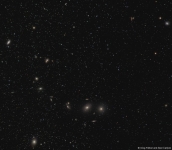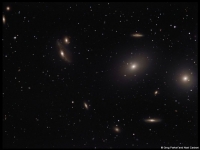Spring is galaxy season in the imager’s diary, and for my April imaging object of the month I am choosing not a single galaxy, but a whole chain of galaxies, Markarian’s Chain at the border of the constellations Virgo and Coma Berenices.
You need a wide field of view to capture this galaxy-rich region of space, and the accompanying image is a 2-frame mosaic using the already large field of view of 3.33 by 2.22 degrees of a single Sky 90/M25C frame!
To get your orientation, the two bright ellipticals at the lower/centre of the image are M84 and M86, towards the bottom left is M87, towards the top right is M99, and towards the top left is M88. I need to take a further 3rd frame to complete this image so that I can capture M89/M90/M91 which all lie off to the left of the current mosaic.
Not being anywhere near as bright as an open cluster (M84 comes in at magnitude 9.1), we need longer sub exposure times than for clusters, and I used 500-second, 720-second and 1,000-second subs in creating this mosaic. If the seeing was good (as it wasn’t) I should have stuck to 1,000-second subs throughout. Each frame should be at least 4 hours total exposure time for a nice noise-free final image.
Just like the Pleiades, it appears that the Markarian Chain area is also asteroid central. In this 2-frame mosaic three asteroids have been captured, to the right of M88 and at the top of the chain is 579 Sidonia at magnitude 12.5. Below M99 is 286 Iclea at magnitude 13.9 and to the left of M87 at magnitude 13.8 is 599 Luisa – a very busy couple of evening’s imaging!
My attempt at imaging this region can be easily improved by taking more, and longer subs for greater depth, and by capturing the region to the left of this image to acquire a large number of extra galaxies that are lurking just outside this field of view.



